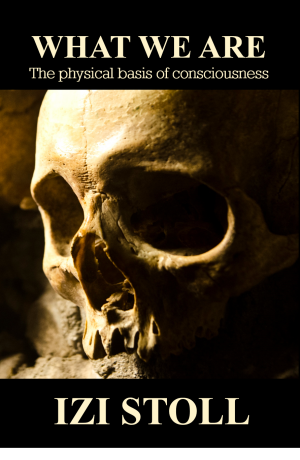Denver, Colorado Nov 15, 2019 (Issuewire.com) - Thought is a real thing, and it is categorically different from neural activity. This is the premise of neuroscientist Dr. Izi Stoll’s new book, What We Are: The Physical Basis of Consciousness.
Many current theories of consciousness dismiss the phenomenon altogether, suggesting that the flow of perception and the incredible experience of self-awareness are nothing more than electrochemical pulses in the brain. Other theories of mind describe consciousness in abstract terms, as a cognitive process. A mechanistic explanation of consciousness, which addresses how the brain actually generates mental states, has proven elusive — until now.
The first in a three-part series on the structure and operation of our universe, the book describes the perceptual experience and the construct of the self as functional outputs of the brain. The stuff of thought is real, and it can be explained through physical processes.
In this book, Stoll demonstrates how the instantaneous integration of electrical activity across a three-dimensional neural network structure, such as the human brain, creates information content which physically exists in higher-dimensional space. This theory proposes that the mind and the brain operate in accordance with the holographic principle, with the mind forming a rich volume of content while the brain encodes that information representationally.
That information content corresponds to a cohesive, streaming, multi-sensory experience - constantly updated in real-time - which can be accessed only by the neural network that produced it. The sum total of all information collected by a single neural network over a lifetime - minus any information which has been rejected or forgotten - is then the model of the self. We are the information sets encoded by our brains.
By combining the laws of neuroscience, statistical mechanics, and thermodynamics, this new theory offers the first plausible physical explanation for the seemingly immaterial nature of thought and a possible mechanism by which mental states may exert change in the neural network state.
“Collectively, this theory shows how neural activity can produce thought. Neural networks are thermodynamic systems with a certain volume and temperature, which exert pressure as charged ions cross into a neuron to change the voltage of that cell. Given that neurons harness the motion of charged particles, each subject to Heisenberg’s uncertainty principle, neurons themselves can be considered probability density functions which encode information representing the sum of all possible particle states. The integration of electrical signals across a neural network, therefore, generates a network-wide probability density function, and information processing effectively converts that network-wide probability state to a defined state. This cycle of probability state generation and probability state collapse is proposed to occur continuously in the brain, generating synchronous activity in neurons that had previously been in a highly-uncertain state,” Stoll explains.
Stoll provides geometrical proof, as well as explanations in terms of physical laws, to demonstrate that neural activity-generated information content must exist in higher-dimensional space. She postulates that is why mental states do not seem to be in the observable universe, although they are generated by and associated with particular patterns of neural activity.
This new approach provides a step-by-step account of cognitive processing, from sensory input to perceptual awareness to the construction of a self with memories and beliefs about the world. It also offers a physical explanation for top-down control, with mental states directly affecting the neural network that gave rise to those states in order to implement goal-directed behavior. Finally, this new mechanistic framework specifies the exact structural and functional requirements for consciousness to manifest in any biological or engineered system, with broad implications for neuroscience, quantum computing, and AI research.
What We Are: The Physical Basis of Consciousness is published by Triskelion Press and is available at Amazon, and other booksellers for $16.00.
About Dr. Izi Stoll
Izi Stoll began conducting neuroscience research in January 2001, while earning her undergraduate degrees in biology and psychology at the University of Illinois. She then completed her Ph.D. in neurobiology and behavior at the University of Washington in Seattle. After conducting post-doctoral research in the United Kingdom, she started her own lab at Newcastle University, leading a team of talented researchers to develop new therapeutic avenues for treating neurological disease. Dr. Stoll has received a number of awards for her research, including a fellowship from the American Federation for Aging Research for identifying how age predisposes cells to cancer formation and recognition from the Society for Neuro Oncology for discovering a new therapeutic intervention for malignant brain tumors. Her work has garnered international press including features in Time Magazine, The Independent, Huffington Post, BBC, and others. She currently directs the theoretical research program at the Western Institute for Advanced Study in Denver, Colorado.
About the Western Institute for Advanced Study
The Western Institute for Advanced Study is explicitly devoted to facilitating specialized research on the challenging problems currently facing science and society, with a highly interdisciplinary and open atmosphere to promote intellectual progress. Each year, the Institute addresses a Grand Challenge in the field of mathematics, physics, or the biological sciences, with a team of Fellows who are highly motivated and well-equipped to pursue the research question. Fellows are given time, space, and support to pursue solutions to the annual Grand Challenge, using their own methodology and working in collaboration with other researchers who have complementary expertise. Find more information on the Institute, as well as previous and ongoing Grand Challenges, at the website: www.westerninstitute.org
Media Contact
Krystal Covington, GO Lead Consulting media@krystalcovington.com 720-515-3078 http://www.KrystalCovington.com










